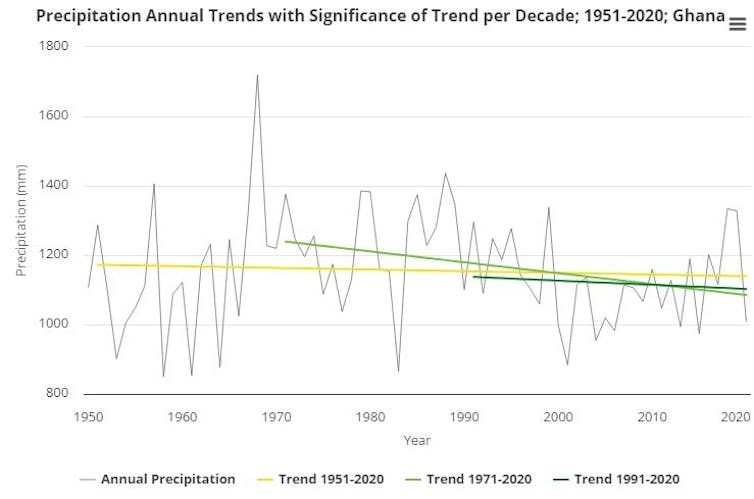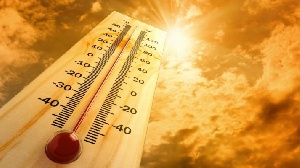Why is Ghana so hot this year? An expert explains
Ghana’s meteorological agency and the state’s health service have issued warnings about a period of very high temperatures expected in the first half of 2024 around the country. Ghana’s experience is part of a global phenomenon: record temperatures were recorded in 2023.
Yaw Agyeman Boafo, the programmes coordinator and a senior research fellow at the University of Ghana’s Centre for Climate Change and Sustainability Studies, answers some key questions.
What is unusual about the weather in Ghana?
Since the 1960s, Ghana has been getting warmer, with temperatures going up by about 1°C – a little over 0.2°C every ten years. There are more really hot days now, with temperatures over 35°C, and this is happening 13% more often each year. The amount of rain that falls can differ from one year to the next. But since the 1960s, there has been less rain overall, with about 2.4% less every ten years, although this is highly variable across the country’s agroecological zones.
The rapid rate of these changes is also a sign that the weather is not following the usual patterns and is part of broader climate change impacts.
Based on available data from the Ghana Meteorological Agency backed by research, Ghana is experiencing a shift towards warmer temperatures. This is unusual in the context of historical climate patterns. These trends point to a changing climate, with the increased likelihood of extreme heat events. This is a global trend.
The Ghana data also suggests that there hasn’t been a consistent pattern in rainfall over the years. There’s evidence of fluctuations in the amount of rain from year to year, but without a clear trend of increase or decrease over the long term.

This lack of a uniform response to rising temperatures is unusual. Normally, we might expect it to get either hotter and drier, or hotter and wetter, depending on how the extra heat affects evaporation and rainfall patterns. The variability poses challenges for agriculture and water supply across the country.
Why is the weather suddenly hot?
A number of factors are at play. Most notable are the effects of human-induced climate change.
The earth’s warming is largely due to the increased amount of greenhouse gases like carbon dioxide, methane and nitrous oxide in our atmosphere. These gases come from burning fossil fuels in cars and factories, deforestation, and certain agricultural practices. Essentially, as we burn fossil fuels and cut down forests, we’re adding more of these gases into the air, which trap heat and cause the planet to warm up. This process is speeding up due to human activities, leading to changes in weather patterns, rising sea levels, and more extreme weather events.
These conditions are supported by empirical data from scientific observations and measurements. For example, weather stations and climate models provide evidence of the trend towards higher temperatures. This scientific data underpins the conclusion that the weather is indeed becoming hotter in Ghana.
Another localised factor is urbanisation. The rapid urbanisation in Ghana, with over half the population living in urban areas (58.62%), contributes to extreme heat in urban areas due to the “urban heat island” effect. This is where buildings, asphalt and reduced greenery absorb and re-radiate heat more than in rural areas.
In Ghana, people living in cities and bigger towns such as Accra, Kumasi, Tamale and Sekondi-Takoradi are already bearing the brunt of extreme heat events.
What’s the effect of rising temperatures?
The effects are multiple.
Urban and rural communities feel the effects in different ways. For urban residents, rising temperatures can affect personal comfort, causing sleep disruption and leading to health concerns.
In addition, heat increases energy demand for cooling, reduces air quality and raises health risks such as acute heat stroke, dehydration, mental fatigue and central nervous system malfunction, particularly in densely populated cities.
Extreme heat also strains health infrastructure and can lead to heat-related illnesses such as heat exhaustion and heatstroke.
Vulnerable households, including older people, children and low-income families, face increased health risks and financial burdens. High out-of-pocket health expenditures strain their financial stability and call for coping strategies that compromise their long term economic well-being.
The productivity and daily lives of urban populations are affected, with alterations in environmental conditions posing challenges to urban agricultural output and overall well-being.
In rural Ghana, farmers face challenges as rising temperatures are damaging vital crops like cocoa, which is the backbone of Ghana’s agricultural sector. This threatens many people’s livelihoods as well as the country’s economy.
In Ghana’s savanna regions for example, rising temperatures are making droughts more severe and rainfall patterns less predictable. This leads to significant challenges including water scarcity, food shortages, increased migration and displacement, and a higher risk of bush fires.
Several studies, including one of my own, have revealed that rising temperatures in northern Ghana influence the incidence and spread of cerebrospinal meningitis.
What needs to be done
To address the issue of rising temperatures in Ghana, a coordinated plan for rural and urban areas needs to be put in place. Reforestation programmes and climate-smart agriculture can help rural communities improve resilience to heat. Water conservation efforts, such as rainwater gathering, would help agriculture survive dry spells. Urban areas could benefit from smart city design that integrates and enhances natural or eco-friendly systems like parks,urban forests,community gardens and the use of reflecting materials in buildings to cool neighbourhoods.
Enhancing renewable energy, promoting clean cooking and lighting, and improving energy efficiency are essential for both rural and urban households to adapt to extreme heat, ensuring safer and cooler living environments. In addition, improving weather forecasts and healthcare services can improve preparedness and response to heat-related health hazards. In all these, community involvement in the design, and implementation of these activities ensures that solutions are relevant and sustainable.









